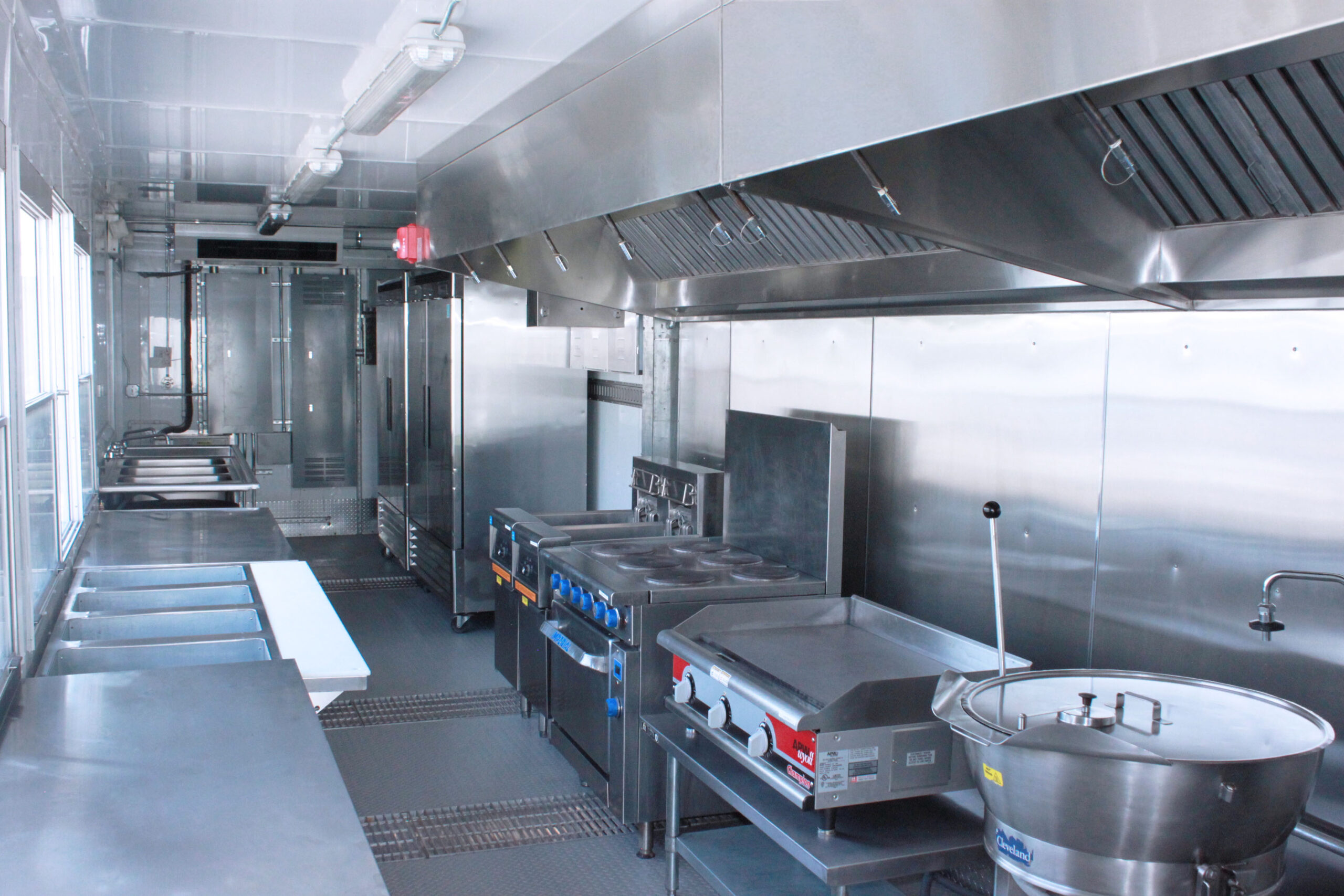
At Pye-Barker Fire & Safety, we’ve spent decades protecting commercial kitchens. Now, as stadiums embrace containerized modular kitchens for their flexibility and efficiency, specialized fire suppression becomes critical to safe operations.
Why Fire Suppression Is Essential
Your containerized kitchen operates like any high-output commercial kitchen – with grills, fryers, and ventilation systems handling grease-laden vapors in a compact space. Cooking equipment remains the leading cause of restaurant fires, making proper suppression non-negotiable.
NFPA 96 mandates that cooking equipment producing grease-laden vapors must be protected by listed fire extinguishing equipment in the hood, plenum, and exhaust duct system. We don’t just meet these standards – we exceed them.
Suppression System Options
| Suppression Type | Mechanism / Agent | Advantages | Limitations / Considerations in Container Kitchens |
| Wet Chemical (Hood / Nozzle Systems) | A potassium-based wet chemical agent is discharged through nozzles over cooking surfaces and inside ductwork, chemically reacting (saponifying) with grease to suppress and cool the fire. | It is the industry standard, well understood, widely accepted per UL and NFPA. It is generally efficient for grease fires, and agents are relatively safe for humans in small exposures. | Requires careful nozzle placement; limited agent volume might constrain coverage in compact containers; careful piping routing is needed in confined spaces; routine maintenance and inspection is critical. |
| Water Mist Systems | Ultra-fine water mist is discharged to cool and displace oxygen. Some designs aim to address grease fires with cooling and dilution. | Potential for lower water usage and less collateral water damage than conventional sprinklers. Some research suggests feasibility in commercial kitchen environments. | Grease fires are notoriously difficult to extinguish with water mist, and risk of re-ignition is nontrivial. Design must be precise; empirical data is limited. |
| Condensed Aerosol / Dry-Particle Systems | A pyrotechnically generated aerosol of microscopic particles is released to interrupt the combustion chemical chain. | Compact storage, potentially lower piping needs, non-pressurized in some designs. | Some aerosols may produce corrosive byproducts or residue, which could harm kitchen equipment. Their effectiveness in direct-grease fire contexts is less standardized in foodservice. |
| Hybrid or Dual-Agent Systems | Combines wet chemical plus water mist or other agents for complementary suppression (fast flame knockdown + cooling). | Can optimize strengths of two approaches, e.g. immediate flame suppression plus thermal control. Some commercial systems (e.g. PIRANHA) are marketed for stadiums, etc. | More complex design and increased maintenance burden; more piping, controls, overlap zones needed; cost may be higher. |
| Sprinkler / Overhead Water Systems | Traditional building sprinkler systems discharge water in zones, but are not typically designed for kitchen grease fires. | Good for general fire control in non-cooking zones, may help contain spread beyond the kitchen. | Not reliable for direct suppression of grease-laden cooking fires (water can spread flaming oil). Thus, sprinklers are not a substitute for hood suppression in kitchens. |
Our recommendation: Wet chemical hood suppression systems remain the proven choice for most container kitchen applications, offering regulatory acceptance and reliable performance.
Container Kitchen Challenges
Stadium containerized kitchens present unique design requirements:
Space Constraints: Limited clearance demands precise routing of piping and nozzles around structural elements while maintaining code compliance and serviceability.
Ventilation Integration: Suppression systems must coordinate seamlessly with hood systems and ductwork, accounting for grease accumulation effects on detection devices.
Complete Coverage: Every cooking appliance and duct segment must fall within protection zones – gaps equal fire spread.
Automatic Shutoffs: Gas and electrical fuel sources require immediate automatic shutoff when suppression activates.
Maintenance Access: System components need accessible placement for regular inspections without disrupting kitchen operations.
Reliability: Redundant coverage, electronic monitoring, and backup systems ensure continuous protection in high-stakes environments.
Regulatory Compliance: All components must meet UL 300 standards and local authority requirements.
The Pye-Barker Approach
Our proven methodology delivers reliable protection:
- Hazard modeling based on fire loads, layouts, and ventilation flows
- UL-listed systems with established kitchen fire suppression records
- Redundant design including overlapping coverage and system monitoring
- Integration with building fire alarms and emergency systems
- Live testing to validate system performance before operation
- Complete documentation and staff training for ongoing maintenance
Protecting Your Investment
Container kitchens represent the future of stadium food service, but they require specialized fire protection expertise. At Pye-Barker Fire & Safety, we combine decades of commercial kitchen experience with stadium application knowledge to design, install, and maintain systems that keep your operations safe and compliant.
Contact Pye-Barker Fire & Safety today to discuss your containerized kitchen fire suppression needs.